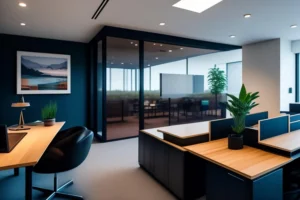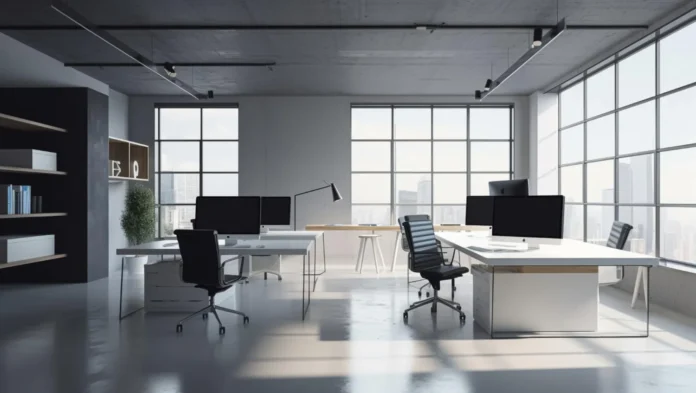In the ever-evolving landscape of workplace design, the debate between open offices and closed offices continues to shape the way we envision and structure our work environments.
Each office layout comes with its set of advantages and challenges, impacting factors ranging from collaboration and communication to individual productivity and overall employee satisfaction.
Let’s dive into a comparative analysis of open offices and closed offices, examining the pros and cons of each to provide insights for businesses navigating the terrain of office design.
Open Office: Fostering Collaboration and Communication
Pros:
Open offices are often hailed for their ability to foster collaboration and communication among team members. The absence of physical barriers facilitates easy interaction, encouraging spontaneous discussions and idea-sharing.
This free-flowing exchange of information can lead to increased creativity, innovation, and a sense of camaraderie among employees. In an open office layout, the visual connectivity promotes a shared sense of purpose, reinforcing a team-oriented culture.
Cons:
However, the very openness that encourages collaboration in an open office can also be a double-edged sword. Noise and distractions can be significant drawbacks, impacting individual concentration and productivity.
The lack of privacy can make it challenging for employees to focus on tasks that require deep concentration or confidentiality. Striking the right balance between collaboration and individual workspaces becomes crucial in optimizing the benefits of an open office environment while mitigating its potential downsides.
Closed Office: Privacy and Focus
Pros:
Closed offices, characterized by individual workspaces separated by walls or partitions, offer a distinct advantage in terms of privacy and focused work. Employees in closed offices have dedicated spaces where they can concentrate without the disruptions prevalent in open layouts.
This environment is particularly beneficial for roles that demand a high level of concentration, such as intricate problem-solving or tasks requiring confidentiality. Closed offices provide employees with a sense of ownership over their workspace, allowing them to personalize it to enhance comfort and motivation.
Cons:
Despite the advantages of privacy and focus, closed offices can sometimes lead to a lack of collaboration and communication. The physical barriers can create a sense of isolation, hindering spontaneous interactions and impromptu idea-sharing.
Additionally, closed offices may contribute to a hierarchical atmosphere, with the physical separation reinforcing distinctions between employees based on their roles or levels within the organization. Striking a balance between providing focused workspaces and encouraging collaboration is essential for optimizing the closed office layout.
Open Office: Flexibility and Adaptability

Pros:
Open offices are often lauded for their flexibility and adaptability to changing work dynamics. The absence of fixed walls and partitions allows for easy reconfiguration of the workspace to accommodate evolving team structures or project requirements.
This adaptability is particularly advantageous for dynamic and collaborative work environments where teams frequently collaborate on different projects. The fluidity of open office layouts allows for quick adjustments to the changing needs of the organization, fostering a sense of agility and responsiveness.
Cons:
On the flip side, the flexibility of open offices can sometimes lead to a lack of designated personal space. Employees may find themselves frequently moving or lacking a consistent area to call their own, potentially impacting their sense of stability and belonging.
The constant visual and auditory stimuli in an open layout can also contribute to a sense of overstimulation, making it challenging for individuals to find a quiet and focused working environment when needed.
Closed Office: Professionalism and Concentration
Pros:
Closed offices are often associated with a sense of professionalism and formality. The delineation of individual workspaces can contribute to a structured and organized atmosphere, which is particularly valuable in industries where confidentiality and professionalism are paramount.
The physical separation provided by closed offices supports a quieter and more focused environment, allowing employees to delve deeply into tasks that require intense concentration.
Cons:
However, the formality and structured nature of closed offices may inadvertently contribute to a hierarchical or rigid organizational culture. The lack of visual connectivity can hinder spontaneous collaboration and limit the organic exchange of ideas.
It’s crucial for organizations adopting closed-office layouts to implement strategies that encourage communication and break down potential silos.
Open Office: Cost-Efficiency and Space Utilization
Pros:
From a cost perspective, open offices often present a more budget-friendly solution. The open layout allows for efficient use of space, accommodating a larger number of employees within a given area. This cost-effectiveness can be particularly appealing for startups or organizations looking to optimize their real estate footprint.
The collaborative nature of open offices can also lead to shared resources, reducing the need for duplicate facilities or equipment in individual workspaces.
Cons:
However, the cost-efficiency of open offices needs to be balanced with considerations of employee well-being and satisfaction. Overcrowded or excessively dense open layouts can contribute to a sense of congestion and reduce the overall comfort of the workspace.
Striking the right balance between maximizing space utilization and ensuring a comfortable work environment is essential for the success of open office designs.
Closed Office: Customization and Personalization
Pros:
Closed offices provide employees with the opportunity to customize and personalize their individual workspaces. The presence of dedicated offices allows for the display of personal items, artwork, or ergonomic adjustments that contribute to a comfortable and motivating workspace.
This personalization can foster a sense of ownership and pride among employees, positively impacting their job satisfaction and overall well-being.
Cons:
However, the customization in closed offices should be mindful not to contribute to a sense of isolation or exclusivity. Striking a balance between personalization and maintaining a cohesive and inclusive workplace culture is essential.
Organizations should encourage personal touches while fostering an environment that remains open to collaboration and shared experiences.
Conclusion
In conclusion, the choice between open offices and closed offices involves a careful consideration of the specific needs, culture, and priorities of an organization. While open offices excel in promoting collaboration and adaptability, closed offices provide a structured and focused environment.
Striking the right balance often involves adopting a hybrid approach that combines the strengths of both layouts, creating a workspace that optimally serves the diverse needs of employees and the organization as a whole.
Keep in mind that the choice of the appropriate fit out company in Dubai is pivotal for ensuring the success of your project, aligning seamlessly with your vision and specific requirements. By selecting the correct office fit out company in Dubai, you have the potential to surpass expectations and craft a workspace that not only meets but inspires success.












